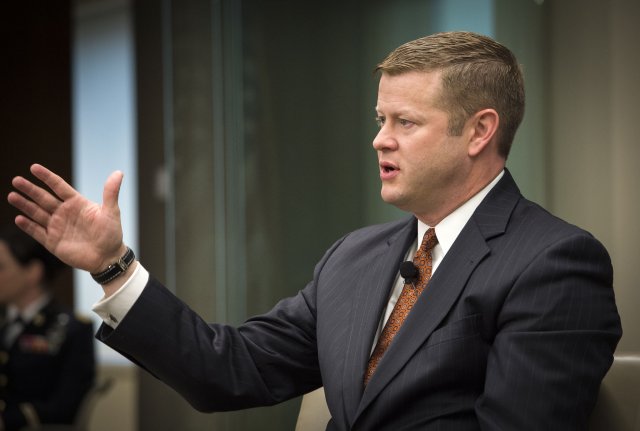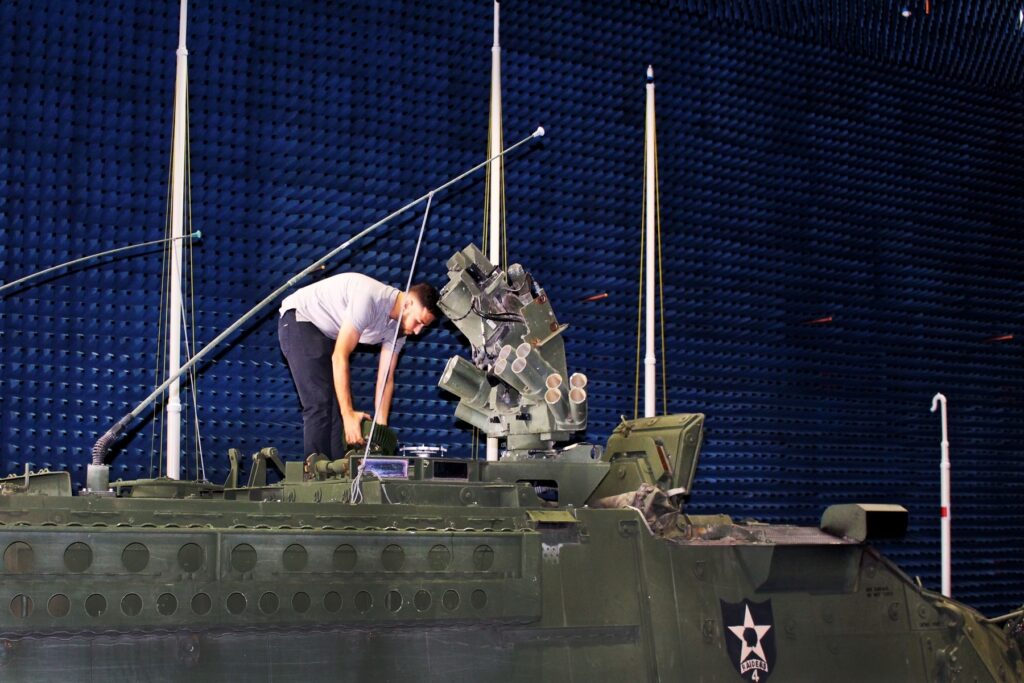
Ryan McCarthy
PENTAGON: Army leaders are scouring their 2020 budget for potential “efficiencies” they can reinvest in their Big Six modernization priorities, Army Undersecretary Ryan McCarthy told me this morning. The goal, he said, is to protect modernization investments even if Budget Control Act caps — aka sequestration — return in 2020 when the current two-year budget deal expires.
“’20 and ’21 is where we need to make sure we don’t kind of hit turbulence,” McCarthy said. “The budget deal was great — we had an enormous increase, and we’re grateful for that — but this still looms (i.e. sequestration). There are areas where we know we can improve our efficiencies — supply chain, healthcare, IT, real property management — (and) we can find additional trade space to protect the RDA (Research, Development and Acquisition) accounts.”
“Efficiencies” is a loaded and ambiguous word in defense debates. It can mean anything from “cuts” (only more polite) to “the check is in the mail.” Agencies have often built budgets around vague efficiencies that never delivered the promised savings. Even genuine efficiency drives don’t necessarily yield a lot of money, warned Todd Harrison, one of the capital’s leading budget experts. “I love efficiencies. Efficiencies warm my heart,” he told me. “But efficiencies, no matter how successful, cannot even begin to insulate the Army from the budget caps returning to their original level in 2020.”
But the Army has already shown its willingness to move real money from lower priorities to invest in the Big Six. In the 2019-2024 budget plan, the service shifted more than a billion dollars in one subset of RDA, Science and Technology (S&T) funding, based on recommendations from the high-level Cross Functional Teams working on the Big Six priorities.
“I am about to have my fourth S&T review” since taking office August first, McCarthy told me. Normally such reviews are an annual affair at best. But the CFTs bring together so many players from across the bureaucracy, compress so many layers of management, and have such direct access to the top Army leaders that they can rapidly cycle through an issue, making recommendations, and then. going back out to investigate the next topic.
The Cross Functional Teams have already made an impact, but they’ll really make their presence felt in the 2020 budget, McCarthy said, repeating something he told me in December. That’s the budget the Army staff is now thrashing out in lengthy discussions. “That’s why I’m late to this meeting,” he told me apologetically — and which goes to the Office of the Secretary of Defense this summer.
McCarthy and Vice Chief of Staff Gen. James McConville, are already meeting with OSD officials to get feedback on the Army’s proposed efficiencies. “It’s much easier if you have the buy in and support (at OSD) ahead of submitting something in the summer,” McCarthy said.
Looking beyond OSD buy in, are there proposed efficiencies — say a Base Reduction And Closure (BRAC) round — that would require Congress to change the law? “Nothing that I’ve seen,” McCarthy told me.

Installing a jamming-resistant antenna on an Army Stryker vehicle inside a massive anechoic test chamber.
Army Futures Command
The Army is overhauling not just its budget but its organization to better serve the Big Six priorities. McCarthy took pains to reassure me that the new Army Futures Command, to which the Cross Functional Teams will belong, will be able to move weapons programs across the infamous valley of death that separates promising new technologies and prototypes from becoming full-scale acquisition programs.
Yes, McCarthy acknowledged, by law, the Program Executive Officers (PEOs) and their subordinate Project Managers (PMs) who run Army weapons programs will continue to report to the Senate-confirmed civilian serving as Assistant Secretary of the Army for Acquisition, Logistics, and Technology, the ASA(ALT). But, McCarthy said, they will also have a substantive relationship to the CFTs and Futures Command as well, not just a dashed line on an org chart.
First of all, the assistant secretary’s military deputy — currently Lt. Gen. Paul Ostrowski — will be “dual-hatted” to hold a key role in Futures Command, McCarthy told me. Having the same person hold both positions makes it much easier for two organizations to communicate and coordinate, with the dual-hatted official able to wield the authorities of both offices as needed for a common goal.
Second, each CFT already includes acquisition officials from relevant programs. Historically, S&T projects gestated deep inside Army or contractor labs and then emerged seeking an acquisition program that would adopt them, use them and fund them. It’s a long, arduous and often unsuccessful pilgrimage across the valley of death. But with the program officials inside the CFT from “the genesis of the concept,” McCarthy argued, they’ll be familiar with new technologies long before they’re asked to sponsor them. They’ll also have input on the projects and help steer them in useful directions that the acquisition programs can actually use.
“Before, S&T would have to go shop it around,” McCarthy said. This way, he said, “your transaction agreement is already written, it’s just waiting to be signed.”
However, he emphasized, the acquisition community must preserve its independence, rather than become merely a subordinate element of the CFTs or Army Futures Command. You don’t want the process so streamlined and the players so in synch that no one stops to wonder if the latest wonder weapon will really work.
“There’s a little bit of necessary tension,” McCarthy said. “That helps prevent groupthink. They’re mutually supporting, there’s better teamwork, there’s relationships established, they can understand and interpret the requirements more efficiently — but at the end of the day there is almost like a firewall… so you can still be that honest broker as the PM (and say) ‘the technology isn’t mature enough, the requirement is too hard.’”
Head start: Early ’25 may be first flight for Black Hawk with T901 engine
Sikorsky is using remaining FARA dollars to test out the new T901 engine in anticipation of integrating it on a UH-60 M Black Hawk later this year.


























